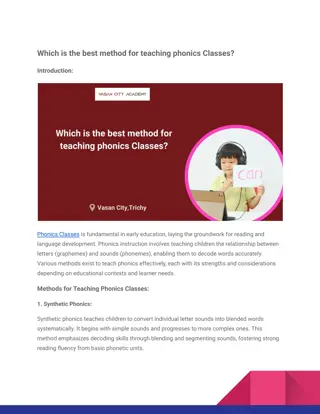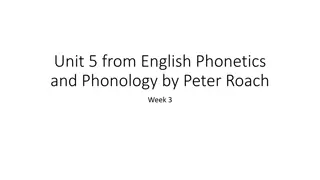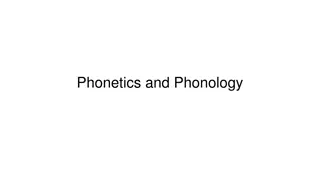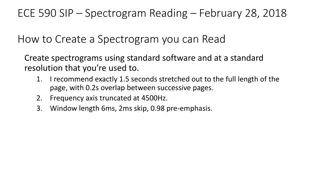Phonics Practice Activities for Elementary Students
Engage elementary students in phonics practice with various activities like identifying initial, medial, and final sounds, blending phonemes to form words, and changing sounds to create new words. The provided examples and word lists enhance students' understanding and application of phonics concept
6 views • 14 slides
Phonemes and Symbols in English Language
Exploring the concept of phonemes and symbols in English language, this content covers the segmentation of speech sounds, phonemic systems, complementary distribution, and allophones. It delves into the theoretical aspects of speech sounds and how different realizations of phonemes impact the meanin
9 views • 15 slides
Language and Linguistics
Language is a fundamental aspect of human communication, encompassing spoken and signed forms. Linguistics delves into syntax, semantics, morphology, phonology, and phonetics to analyze language structure and meaning. Phonetics explores how speech sounds are produced and perceived, shedding light on
9 views • 10 slides
_Which is the best method for teaching phonics Classes_
Phonics Classes is fundamental in early education, laying the groundwork for reading and language development. Phonics instruction involves teaching children the relationship between letters (graphemes) and sounds (phonemes), enabling them to decode
1 views • 3 slides
Grapheme Introduction and Practice Activities
Explore the introduction of new graphemes, connecting them with phonemes, and identifying their placement in words. Engage in practice activities with sample words and select games for reinforcement.
0 views • 10 slides
Explicit Phonics Instruction S.A.T.P. Lesson 4
NSW Department of Education introduces a lesson on graphemes representing phonemes to help students read and spell words. The learning intention is to use these graphemes effectively, with success criteria focused on reading and writing words. The lesson includes various slides to reinforce the conc
0 views • 37 slides
Overview of Little Wandle Letters and Sounds Programme
Little Wandle Letters and Sounds Revised is a government-recommended phonics and early reading programme designed to help children fluently decode and read texts using phonics by the end of Year 1. Parents play a vital role in supporting children's reading development, as fluency by age 6 correlates
2 views • 18 slides
The Functional Aspect of Speech Sounds
The functional aspect of speech sounds delves into the concept of phonemes, phonological and phonetic mistakes in pronunciation, main trends in the phoneme theory, and methods of phonological analysis. It explores the definition of phonemes, the three aspects of phonemes, and the different views on
1 views • 30 slides
Little Wandle Phonics Programme for Early Reading Success
Little Wandle Letters and Sounds Revised is a government-recommended phonics programme aimed at ensuring children can fluently decode and read using phonics by the end of Year 1. With daily phonics teaching, group reading, interventions, and assessments, parents play a crucial role in supporting the
0 views • 24 slides
Phoneme Counting Bead String Activity
Engage students in segmenting and counting phonemes in words using a model with beads. Guide students to move a bead for each sound they hear, promoting phonemic awareness. Students can control the movement themselves if able, enhancing remote learning experiences.
0 views • 8 slides
Interactive Grapheme Introduction Activities for Phonics Learning
Engage students in interactive activities to introduce new graphemes, connect them with corresponding phonemes, and demonstrate their placement in words. Explore sample words, practice reading, and play games to reinforce learning. Enhance phonics skills with fun quizzes and word reading activities.
0 views • 15 slides
Infant Phonetic Development: Stages and Characteristics
Infant phonetic development progresses through distinct stages, from basic biological noises like crying to babbling and beyond. Each stage highlights vocal milestones such as cooing, vocal play, and babbling, leading to the expansion and contraction of phonemes. The transition to melodic utterance
1 views • 5 slides
Improving Spelling Skills for Better Learning
Enhancing spelling skills is crucial for academic success. The program highlights the evolution of spelling education, emphasizing the progression from limited reinforcement to daily, multi-sensory teaching methods. Structured stages, such as Stage 1 focusing on initial sounds and phonemes, facilita
0 views • 48 slides
Phonogram Word Cards for Teaching Phoneme-Grapheme Correspondences
Explore a collection of phonogram word cards featuring various phoneme-grapheme correspondences for educational activities like word sorts and review games. Enhance phonics skills with word lists containing words sharing the same phonogram, covering a wide range of graphemes and phonemes. Utilize th
1 views • 32 slides
Phonics: The Key to Reading Success
Phonics is a method of teaching the connection between sounds and letters to help children learn to read and spell. It involves recognizing phonemes, blending sounds to form words, and assessing proficiency through screenings. The phases of phonics progress from basic letter sounds to more complex d
0 views • 30 slides
Phonetics and Phonology: Key Concepts and Differences
Phonology investigates sound distribution and interaction in language, providing an inventory of sounds and their interactions. Phonotactic constraints outline permissible sound sequences within a language, while phonemes and allophones distinguish between abstract and physical sound entities. Ident
0 views • 21 slides
Effective Phonics Teaching Strategies for Year One Children
Explore the structured phonics teaching programme aiming to meet Year One standards, emphasizing the importance of phonics for reading and writing skills development. Engage with daily interactive activities, games, and partner work sessions for 20 minutes each day. Learn key definitions such as gra
0 views • 14 slides
Phonics: A Key to Reading Success in Year 1
Phonics is a fundamental approach to teaching reading by breaking down words into sounds (phonemes) and blending them together. It aids in developing essential reading and spelling skills in children, leading to a positive school experience. The 44 phonemes and corresponding graphemes play a crucial
0 views • 24 slides
Devanagari Sanskrit Writing System
Explore the beauty and complexity of the Devanagari writing system used for Sanskrit and other Indic languages. Learn about its unique order of letters, aspirates, phonemes, and intricate vowel structures. Discover why Devanagari is a fascinating script to study and appreciate.
0 views • 8 slides
Supporting Your Child's Spelling Skills at Home
Enhance your child's spelling abilities with fun games and helpful approaches. Starting with basic words, progress to more complex spellings using phonemes, graphemes, and diagraphs. Encourage letter recognition and word formation using playful activities like letter sorting and circle spellings. Fo
0 views • 18 slides
Fun and Interactive Learning Activities with Geraldine the Giraffe
Engage children in a fun learning experience with activities such as singing the alphabet song, exploring new phonemes, and building words with magnetic letters. Follow along with Geraldine the Giraffe to discover words containing the "ng" sound. Boost literacy skills in an engaging way!
0 views • 6 slides
Spelling and Phonics Practice Schedules for Improved Vocabulary
Enhance your vocabulary and spelling skills with a structured weekly plan focusing on tricky words, syllables, phonemes, and spelling strategies. Each day targets specific areas such as homophones, phonemic awareness, and effective spelling techniques to help you master challenging words effortlessl
0 views • 16 slides
English Phonetics and Phonology: An Introduction
The study of English phonetics and phonology is essential for understanding the physical characteristics of human speech sounds and their distribution in language systems. Phonetics focuses on the sounds themselves, while phonology delves into their classification and patterns within a language. Key
0 views • 8 slides
Phonemes and Phonology in English
Exploring the concept of phonemes and phonology in English phonetics, this text discusses how sounds are produced, segmented, and categorized. It delves into the abstract string of sound units known as phonemes, different realizations of the same phoneme called allophones, and the use of symbols and
0 views • 7 slides
Invitation for Study of Enets Prosody: Phonology and Intonation Insights
Explore Enets phonology and intonation with Olesya Khanina from the Institute of Linguistics, Russian Academy of Sciences. Discover the unique set of phonemes, patterns of variation, and stress patterns at the word level. Uncover interesting questions about Enets prosody through digital corpora anal
0 views • 21 slides
Phonology: The Study of Speech Sounds in Language
Phonology is a branch of linguistics that focuses on the organization and usage of speech sounds in natural languages, with phonemes being the smallest units of sound that carry meaning. This field explores the sound structure of languages, highlighting the variety of phonemes present across differe
0 views • 19 slides
Introduction to Theoretical Phonology: Understanding Phonemes and Speech Sounds
The lecture explores the fundamental concepts of phonology, focusing on phonemes, speech sounds, phonological theories, and their historical background. It delves into the functions of phonemes in forming language units, distinguishing words, and their connection to meaning. Various theories and fun
0 views • 43 slides
An Alternative Phonetically-Based Phoneme Analysis of the Danish Consonant System
This study challenges the standard analysis of the Danish consonant system, proposing a new phonetically-based approach. It critiques the outdated standard analysis that links unaspirated plosives with semivowels, arguing that the alternative analysis is more in line with phonetic facts and easier t
0 views • 19 slides
Grapheme Introduction and Practice Activities
Explore grapheme introductions and practice activities in this engaging educational material. Learn how to connect graphemes with phonemes, identify their placement in words, and practice reading new words. Discover fun practice games and word lists to enhance your skills.
0 views • 9 slides
Speech Signal Processing and Phonemes
Delve into the world of speech signal processing, exploring applications like speech storage, recognition, and synthesis. Discover how different languages utilize phonemes to convey meaning through various acoustic units. Uncover the intricacies of speech sampling and phoneme types, from vowels to c
0 views • 73 slides
Comprehensive Overview of Phonics Teaching Methods and School Values
Delve into the world of phonics instruction and school values with detailed explanations on essential concepts such as phonemes, graphemes, and teaching methodologies. Discover the importance of high expectations, PE, cursive handwriting, and more in shaping well-rounded learners.
0 views • 15 slides
Learning Phonics and Vocabulary in Early Education
Breaking down words into sounds, understanding phonemes, CVC words, mnemonic techniques, tricky words, segmenting, blending, digraphs, and consolidating learning through the 6 phases of Letters and Sounds in early education to develop foundational language skills.
0 views • 13 slides
Explicit Phonics Instruction S.A.T.P Lesson 3
Explore the explicit phonics instruction lesson focusing on the S.A.T.P graphemes representing phonemes to enhance reading and spelling skills. Follow the NSW Department of Education's learning intention and success criteria to effectively use graphemes in reading and writing words. Engage with a se
0 views • 26 slides
Decoding Spectrograms Using the Crossword Puzzle Method
Learn how to decode spectrograms for speech analysis by using the Crossword Puzzle Method. This method involves identifying phonemes, grouping them with IPA symbols, and forming sequences to decipher speech patterns accurately.
0 views • 5 slides
Phonological Interference in French BIPA Students: A Literature Study
BIPA students face challenges in pronunciation due to phonological interference, especially in French-speaking students. This study explores the linguistic aspects contributing to pronunciation errors and proposes phonetic corrections. Literature review discusses language interference and factors in
0 views • 11 slides
Interactive Grapheme Introduction Activities for Phonics Learning
Explore a series of engaging activities to introduce new graphemes, connect them with corresponding phonemes, demonstrate their usage in words, and practice reading in a fun and educational way. Sample words and interactive games included to enhance learning experience.
0 views • 16 slides
Remote Learning Phonics Lesson Outline for Reception Students
In this remote learning session, Reception students will review Phase 2 and 3 phonemes, digraphs, and tricky words. They will learn and practice new tricky words, practice writing them, and read sentences containing tricky words. The lesson includes various visual aids and slides to engage students
0 views • 70 slides
Proto-Austronesian Reflexes in Maya Language of West Papua
Maya language, spoken by the Maya community in Waigeo Island, West Papua, is related to South Halmahera languages. This research aims to identify phonological features of Maya as part of this subgroup. Contradictory opinions exist regarding the concept of South Halmahera-West New Guinea. The study a
0 views • 7 slides
Language Components and Phonemes in Communication
Explore the components of language, from individual letters and sounds to phrases and sentences. Learn about phonemes, the sounds in spoken language, and how they vary among different languages. Engage in activities to enhance your understanding of linguistic elements in communication.
0 views • 14 slides
Remote Learning Phonics Lesson for Reception Students
In this remote learning session, Reception students will recap phase 2 and practice phase 3 tricky words, phonemes, digraphs, and trigraphs. They will learn a new trigraph sound, read and write new words and sentences. The lesson includes interactive slides to engage students in independent tasks re
0 views • 73 slides







































